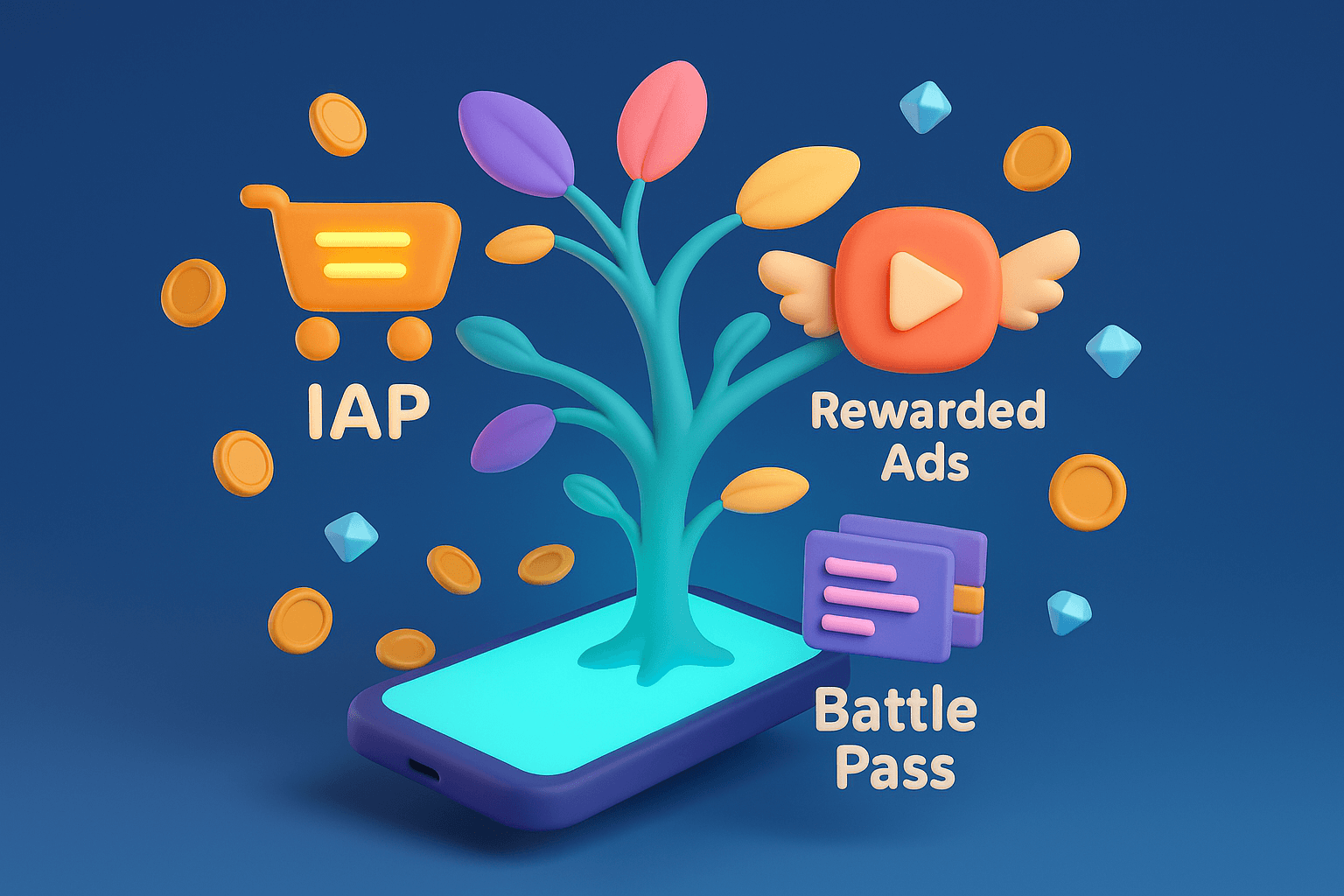The global gaming market is set to surpass an astonishing $300 billion in 2025, a testament to its cultural and economic power. Yet, within this thriving industry lies a common paradox: countless developers create brilliant, engaging, and technically sound games but struggle to turn their passion into profit. A great game is only half the battle. The other, equally important half, is a smart and well-executed monetization plan. That’s why understanding and implementing effective game monetization strategies for 2025 is no longer just a business task—it’s an essential part of game design itself.
The landscape is shifting. Players are more discerning, and aggressive, experience-ruining tactics are being rejected. This guide will break down the top 7 modern strategies—from evolved classics to emerging frontiers—that will define success for both mobile game monetization and web game monetization in the year ahead.
The Golden Rule of 2025: Player Experience (PX) First
Before we dive into specific models, we must establish the foundational principle of modern monetization: Player Experience (PX) is paramount. The era of disruptive, mandatory ads and cynical “pay-to-win” mechanics is fading. Today’s most successful games understand that long-term revenue is a direct result of high user retention. You can’t monetize players who have already left your game out of frustration.
A successful strategy in 2025 doesn’t interrupt the core gameplay loop; it complements it. It offers value, provides options, and respects the player’s time and investment. Every model we discuss below should be viewed through this lens. If one of the game monetization strategies for 2025 enhances the player experience… it has the potential for success.

The Core Monetization Models: A Deep Dive
These three models form the bedrock of almost every successful monetization plan today. However, their implementation has evolved to be more sophisticated and player-centric.
Strategy 1: In-App Purchases (IAPs) – Evolved
In-app purchases are the classic powerhouse of mobile gaming revenue. However, the nature of what players are willing to buy has matured.
- Consumables: These are single-use items like in-game currency, energy boosts, or extra lives. They remain effective, especially in puzzle and casual games, but must be balanced carefully to avoid feeling like a mandatory tax to keep playing.
- Durables: These are permanent purchases, such as unlocking a new character, level pack, or, most commonly, an “ad-free” version of the game. Offering a paid, ad-free option is a crucial part of any hybrid model.
- Cosmetics (Skins, Outfits, etc.): This is arguably the most powerful and player-friendly form of IAP. Cosmetic items allow for self-expression without affecting gameplay balance. Players are happy to pay for items that make their characters or profiles look unique. This model creates a revenue stream based on desire, not necessity, fostering goodwill with your player base.
Strategy 2: Ad-Based Monetization – Done Right
In-game advertising is more nuanced than ever. Simply throwing up banner ads is ineffective. The focus is now on integrated, value-exchange formats.
- Rewarded Video Ads: This is the gold standard of ad-based game monetization. The premise is simple: the player voluntarily chooses to watch a short video ad in exchange for a meaningful in-game reward (e.g., extra currency, a second chance after failing a level, a temporary boost). It’s a win-win-win: the player gets a valuable reward, the developer earns ad revenue, and the advertiser gets an engaged viewer.
- Interstitial Ads: These are the full-screen ads that appear between game sessions (e.g., after completing a level). While they can be interruptive, their effective use in 2025 hinges on timing and frequency. They should appear at natural breaks in gameplay and should be skippable after a few seconds.
- Offerwalls: An offerwall presents players with a list of tasks (like completing a survey or installing another app) in exchange for large amounts of in-game currency. This can be a significant revenue driver but should be implemented as an optional, opt-in feature.
Strategy 3: The Hybrid Model – The New Standard
Very few successful games in 2025 rely on a single source of income. Hybrid monetization models, which combine IAPs and advertising, are now the industry standard. This approach provides multiple revenue streams and gives players a choice in how they interact with the game’s economy. A player who never spends money on IAPs is still valuable through ad views. A “whale” who spends heavily can be offered an ad-free experience as part of their investment. This flexibility is a core part of modern game monetization strategies for 2025 and maximizes the lifetime value (LTV) of every single player.
Advanced & Emerging Game Monetization Strategies for 2025
To truly dominate the market, developers need to look beyond the basics and embrace the strategies that are defining the future of game monetization.
Strategy 4: The Subscription & Battle Pass Revolution
Inspired by the massive success of games like Fortnite, subscription models and the Battle Pass (or Season Pass) system have become mainstream. Instead of one-time purchases, this model offers recurring revenue. Players pay a set fee (monthly or per season) to gain access to a stream of exclusive content, cosmetic items, and challenges. It’s a powerful tool for boosting both revenue and long-term user retention, as players feel invested in completing the pass before the season ends.
Strategy 5: Live Ops and Limited-Time Events
A modern game is not a static product; it’s a live service. “Live Ops” refers to the practice of continually updating the game with new content, promotions, and, most importantly, limited-time events. These events (e.g., a week-long Halloween-themed challenge) create excitement and urgency. By offering exclusive rewards or special bundles available only during the event, This approach is one of the most dynamic game monetization strategies for 2025, creating revenue spikes while keeping the game fresh.
Strategy 6: Data-Driven Personalization
One-size-fits-all monetization is dead. In 2025, leveraging data is key. By analyzing player behavior, developers can segment their audience and present them with personalized offers. A highly engaged player might receive a high-value bundle offer, while a new player might be shown a starter pack. This extends to ads as well, showing more relevant advertising based on player profiles. However, this must be done with immense respect for data privacy. Regulations like GDPR and Apple’s App Tracking Transparency (ATT) mean that developers must be transparent and ethical in how they use player data.
Strategy 7: The Web3 Frontier (A Cautious Look)
No discussion of future monetization is complete without mentioning Web3, NFTs, and play-to-earn (P2E) models. These blockchain-based systems allow for true ownership of in-game assets, which can then be traded or sold. While the initial hype has cooled, the underlying technology still presents intriguing possibilities. However, this frontier is volatile. Many players remain skeptical, and the technical and economic challenges are significant. For 2025, this is a strategy to watch and experiment with cautiously, rather than to bet the entire farm on.
How to Choose the Right Strategy for Your Game
So, how do you choose from all the available game monetization strategies for 2025? The right monetization mix depends heavily on your game’s genre and target audience. Here’s a quick cheat sheet:
- For Hyper-Casual Games: The primary model is Ad-Based Monetization, especially Rewarded Video Ads. Pair this with a single, compelling IAP: the “Remove Ads” option. The goal is to monetize a massive volume of players with light engagement.
- For Core/Strategy/RPG Games: The focus is on deep engagement and player investment. Lead with IAPs (cosmetics, convenience items) and a compelling Battle Pass system. Use Live Ops to drive repeat spending. Ads are often secondary or non-existent to preserve the immersive experience.
- For Casual/Puzzle Games: This is the sweet spot for Hybrid Monetization. Use a mix of IAPs (boosters, extra lives) and Rewarded Video Ads. The goal is to give players the choice to either pay or watch ads to progress.
Conclusion: Monetization as Part of the Design
The most successful developers in 2025 will be those who integrate their game monetization strategies for 2025 directly into the design process. It is an integral part of the game’s design loop and a key factor in the overall player experience. There is no single “best” solution, but the overarching trend is clear: the future is hybrid, player-centric, data-informed, and constantly evolving.
Choosing the right game monetization strategies for 2025 is a complex but critical decision that will define your game’s commercial success. By understanding these top strategies and tailoring them to your specific game and audience, you can build a sustainable revenue model that respects your players and fuels your studio’s growth for years to come.
Designing the right monetization model is as crucial as the development itself. If you need help with either step, from outsourcing HTML5 game development to crafting the perfect revenue strategy, our experts can guide you.
